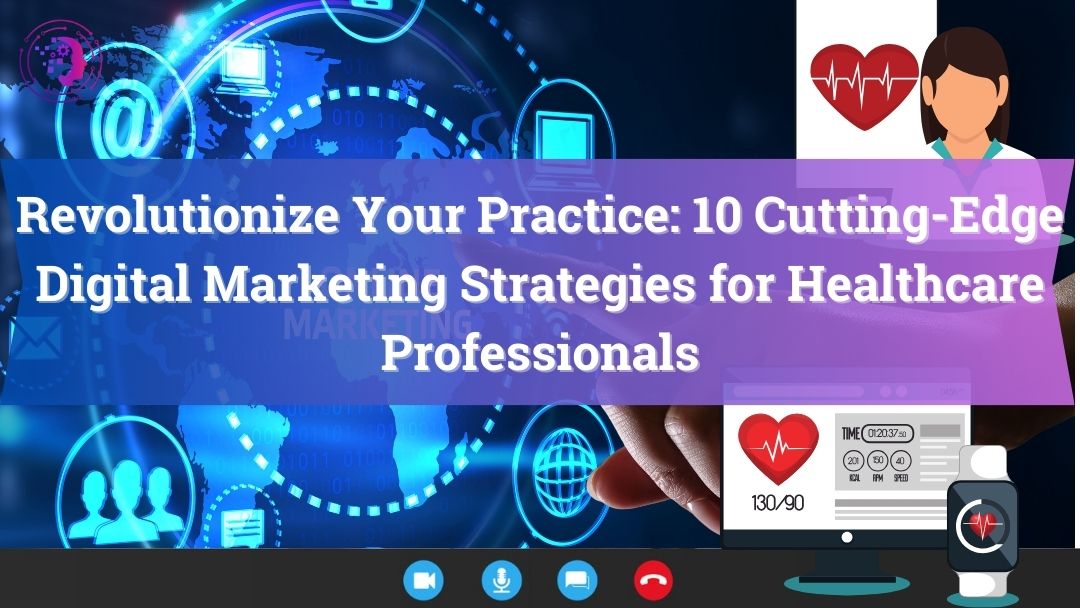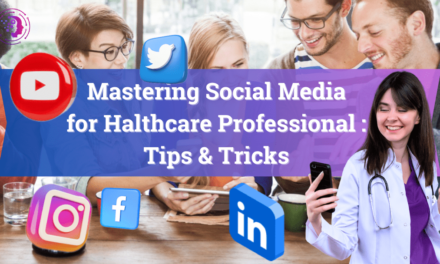
Revolutionize Your Practice: 10 Cutting-Edge Digital Marketing Strategies for Healthcare Professionals

This post may contain affiliate links, which means I may earn a commission for purchases made through these links. Your support will encourage us to continue adding value to you through blogs like this. Learn more on my Private Policy page.
Introduction
Welcome to Dr. Digital’s blog, where we dive into the world of cutting-edge digital marketing strategies for healthcare professionals. In today’s fast-paced and technology-driven world, it’s essential for healthcare providers to revolutionize their practice by leveraging the power of digital marketing. Whether you’re a physician, dentist, chiropractor, or any other healthcare professional, understanding and implementing these strategies can help you reach and engage with patients in new and exciting ways. Let’s explore five game-changing digital marketing approaches that can elevate your practice and help you stay ahead in the competitive healthcare landscape.
1. Leveraging Social Media
Engaging with patients on various social media platforms is a key strategy to provide valuable health information and address their concerns in real time. By utilizing targeted advertising, healthcare professionals can reach specific demographics and increase visibility among potential patients, ensuring that their message reaches the right audience. Creating interactive posts and hosting live Q&A sessions fosters better engagement and builds a strong online community, encouraging open communication and relationship-building. Sharing success stories, testimonials, and educational content not only establishes credibility and trust with the audience but also provides valuable insights and inspiration for those seeking healthcare guidance.
Engage with patients on various social media platforms.
- Consistently Engage: It’s crucial to regularly interact with your audience’s comments and messages to show genuine interest in their questions and feedback.
- Encourage Active Participation: Utilize polls, surveys, and health-related challenges to encourage active involvement, gaining valuable insights from your audience’s viewpoints.
- Collaborate with Influencers: Partnering with healthcare influencers and professionals can broaden your reach, bringing diverse perspectives to enrich your online community.
- Promote Wellness Events: Utilize social media to announce wellness events, workshops, and webinars, attracting more participants and keeping them informed about relevant opportunities for learning and personal growth.
Utilize targeted advertising to reach specific demographics
– Tailoring ad copies to resonate with diverse demographic groups is crucial for effective digital marketing in healthcare.
– A/B testing for ad variations helps identify the most effective messaging for each target demographic.
– Implementing advanced targeting options such as geolocation, interests, and behaviors optimizes ad delivery for maximum impact.
– Tracking key metrics like click-through rates, conversions, and impressions is essential to measure the performance of targeted advertisements and make informed adjustments for better results.
2. Leverage Data-Driven Insights
Utilizing advanced data analytics is crucial for understanding patient demographics and behavior, enabling healthcare professionals to tailor their marketing strategies to specific groups effectively. By implementing a data-driven approach, personalized patient communication and outreach can significantly enhance engagement and retention. Analyzing digital marketing metrics plays a vital role in optimizing advertising spend and maximizing ROI for healthcare services. Moreover, embracing predictive modeling allows healthcare professionals to forecast patient needs accurately and tailor their services accordingly, ultimately leading to improved overall patient satisfaction.
Utilizing Advanced Analytics
– Applying machine learning algorithms to analyze patient data empowers healthcare professionals to make proactive decisions that can significantly improve patient outcomes.
– Predictive analytics enables healthcare professionals to anticipate trends in patient inquiries and tailor marketing efforts for better conversion rates.
– Implementing sentiment analysis not only measures patient satisfaction but also offers valuable insights into patient sentiment towards healthcare services, guiding improvement strategies.
– Cohort analysis helps segment patients based on their characteristics and behaviors, allowing healthcare professionals to customize marketing strategies for each group, leading to a more personalized approach to patient care and communication.
Implementing Predictive Modeling
– Leverage historical patient data to predict future health needs and proactively offer relevant healthcare services.
– Employ predictive modeling to anticipate appointment cancellations or no-shows, optimizing scheduling and resource allocation.
– Utilize predictive models to identify high-risk patients and provide targeted interventions for better health outcomes.
– Implement machine learning algorithms to predict potential health issues in individual patients, enabling preventive care strategies and improving overall patient care and satisfaction.
3. Content Marketing
To effectively educate patients about preventive care and showcase the practice’s expertise, developing engaging blog posts and articles is essential. Sharing informative videos and infographics on social media platforms not only increases patient engagement but also enhances brand awareness. Additionally, creating email newsletters with valuable health tips and updates can nurture patient relationships and encourage repeat visits. Collaborating with influencers or other healthcare professionals to co-create content is a powerful strategy to expand the practice’s reach and credibility. These digital marketing strategies not only inform and engage patients but also strengthen the practice’s position as a trusted source of healthcare information.
Create valuable and educational content for patients
– Empowering patients: Providing valuable information to help patients make informed decisions about their health.
– Building trust: Showcasing testimonials and success stories from satisfied patients to build trust in the practice and highlight its positive impact on patient care.
– Wellness resources: Sharing healthy recipes and exercise routines to establish the practice as a source of holistic support and promote overall well-being.
– Patient engagement: Hosting live Q&A sessions on social media to directly address patient queries in real-time, fostering a sense of community and enhancing patient engagement.
Implement SEO strategies to boost online visibility
– Optimizing website content with relevant keywords is crucial for improving search engine rankings and making it easier for potential patients to discover your practice online.
– Creating location-specific landing pages can significantly enhance local visibility, attracting nearby patients seeking healthcare services.
– Obtaining backlinks from reputable medical websites can increase the practice’s authority in search engine algorithms, ultimately boosting organic traffic.
– Regularly publishing fresh, original content signals search engines that the practice is active and relevant, contributing to an improved overall online visibility.
– Implementing these cutting-edge digital marketing strategies can revolutionize your practice’s online presence and attract more patients.
4.Engage with Interactive Content
Revolutionizing your practice involves creating engaging and informative virtual tours of your healthcare facility to provide patients with an immersive experience, enabling them to familiarize themselves with your environment before their visit. Developing interactive educational videos to explain complex medical procedures and treatments in a visually engaging way can enhance patient understanding and satisfaction. Additionally, utilizing interactive quizzes and assessments on your website to educate patients about various health topics while keeping them engaged is a modernized strategy. Implementing gamified elements such as reward systems and challenges into your patient education materials makes learning more enjoyable, ultimately improving patient engagement and retention of important health information.
Utilizing Virtual Reality Experiences
– Enhance decision-making skills: Utilize VR simulations for medical staff to improve their decision-making skills in high-pressure scenarios, ultimately leading to better patient outcomes.
– Improve patient experience: Create VR relaxation experiences for patients undergoing stressful procedures to promote a sense of calm and reduce anxiety, enhancing their overall experience.
– VR therapy for pain management: Offer VR therapy sessions for pain management and rehabilitation to complement traditional treatment methods and provide patients with a more immersive and effective approach to healing.
– Personalized remote consultations: Utilize VR for remote patient consultations to personalize the interaction between healthcare professionals and patients, creating a deeper level of engagement and understanding.
Integrating Interactive Chatbots
– Implement chatbots on your website to provide instantaneous responses to common patient inquiries, ultimately improving overall customer service.
– Incorporate chatbots into appointment scheduling systems to streamline the process and offer real-time availability updates to patients, enhancing their experience.
– Utilize chatbots for medication reminders and symptom tracking to aid patients in adhering to their treatment plans more effectively.
– Integrate conversational chatbots into telemedicine platforms to enhance the virtual healthcare experience for patients, fostering natural language interactions and personalized care.
– These cutting-edge digital strategies leverage chatbot technology to optimize patient engagement and operational efficiency.
5. Telemedicine and Virtual Care
Incorporating telemedicine into your practice not only expands your reach but also provides convenient and timely healthcare services to patients, regardless of their location. By embracing virtual care, you can offer consultations and follow-ups, reducing wait times and enhancing patient engagement through ongoing monitoring of their health status. Additionally, leveraging telemedicine for second opinions and specialist consultations allows you to provide comprehensive care and expertise beyond the physical constraints of your practice, ultimately revolutionizing the way healthcare services are delivered.
Offer virtual consultations and follow-ups
– Enable patients to schedule virtual appointments for non-emergency medical concerns or follow-up visits, providing them with the flexibility to receive medical advice from the comfort of their homes.
– Offer a seamless digital experience with secure video conferencing for virtual consultations, prioritizing their privacy and ensuring easy access to essential healthcare services.
– Provide clear instructions for virtual follow-ups and consultations to ensure effective communication, ultimately enhancing their overall experience and satisfaction with your practice.
– Embrace telemedicine and virtual care to revolutionize patient care, meeting their needs with modern, cutting-edge digital strategies.
Provide secure and user-friendly telemedicine platforms
– Invest in reliable platforms with robust security measures to safeguard patient information.
– Prioritize user-friendly interfaces to ensure a positive experience for both patients and healthcare professionals, fostering seamless virtual interactions.
– Integrate features such as online appointment scheduling and prescription management to enhance convenience for all parties involved.
– Offer comprehensive technical support to ensure that both patients and staff can effectively utilize the telemedicine platform, optimizing the digital healthcare experience.
6. Optimize for Mobile Experience
In order to provide a seamless user experience, it’s crucial to ensure that your website is responsive and loads quickly on mobile devices. By utilizing mobile-friendly design elements such as larger fonts and buttons, you can enhance navigation on smaller screens, optimizing the user experience. Additionally, optimizing images and videos for mobile viewing minimizes load times and improves overall performance. Implementing touch-friendly gestures and interactions further enhances the usability of your mobile website, catering to the preferences and behaviors of mobile users.
Creating Mobile-Friendly Websites
– Mobile Traffic Growth: Mobile traffic is on the rise, emphasizing the need for healthcare professionals to prioritize the mobile experience.
– Clean and Adaptable Layout: Focusing on a clean and adaptable layout is crucial to ensure a consistent user experience across various screen sizes.
– Fast Loading Times: Fast loading times, optimized images, and efficient coding techniques are essential for mobile optimization.
– Mobile SEO Best Practices: Incorporating mobile SEO best practices enhances visibility in search engine results for mobile users.
– Regular Testing: Regular testing across different devices helps identify and address any usability or compatibility issues, ensuring a seamless mobile experience for patients and visitors.
Leveraging Mobile Apps for Patient Engagement
– Develop interactive and user-friendly mobile apps to offer patients convenient access to healthcare resources and services.
– Integrate features such as appointment scheduling, telemedicine options, and health tracking tools to enhance patient engagement and foster a seamless healthcare experience.
– Personalize the app experience by delivering relevant content based on individual patient preferences and medical history to further enhance patient satisfaction.
– Enable secure communication channels within the app to facilitate direct interaction between patients and healthcare professionals, ensuring timely and personalized care.
7. Mobile Health Apps
Revolutionize the way you engage with patients by developing custom apps tailored to their specific healthcare needs. By delivering interactive educational content through these apps, you can empower patients to take control of their health and improve their adherence to treatment plans. The engaging and user-friendly interfaces of these apps will not only increase patient satisfaction and loyalty but also enhance their overall healthcare experience. By providing personalized digital tools and resources, you can truly revolutionize patient education and engagement, setting a new standard for healthcare professionals everywhere.
Develop custom apps for patient education and engagement
– Create interactive content to enhance patient understanding of medical conditions and treatments.
– Tailor app features to facilitate seamless communication between healthcare providers and patients for better engagement and support.
– Offer personalized health tips, reminders, and resources through the custom app to ensure ongoing patient support and empowerment.
– Incorporate gamification elements to make learning about healthcare more enjoyable and engaging for patients, enhancing their overall experience.
Integrate health tracking and monitoring features
Implementation of advanced tracking features enables real-time monitoring of vital signs, symptoms, and overall health trends.
– Real-time data allows for timely interventions and personalized care tailored to individual health needs.
– Seamless integration with wearable devices ensures accurate data collection and analysis, providing healthcare professionals with valuable insights.
– Personalized feedback based on tracked data encourages healthy lifestyle choices and empowers patients to take control of their well-being.
– Data security and privacy compliance are crucial when utilizing health tracking technologies to safeguard patient information, thereby fostering trust and confidence in digital healthcare solutions.
8. Embrace Telemedicine Platforms
Revolutionize your practice by embracing telemedicine platforms, allowing you to reach and treat patients remotely, transcending the limitations of traditional in-person visits. These platforms enable healthcare professionals to provide timely care and medical advice to patients in remote or underserved areas, expanding the scope of your services. By leveraging telemedicine platforms, you can streamline appointment scheduling, reduce patient wait times, and ultimately enhance overall patient satisfaction. Furthermore, the secure video consultations offered by telemedicine platforms provide a means to maintain patient privacy while delivering high-quality care, aligning with the evolving digital landscape of healthcare.
Implementing Virtual Consultations
– Implementation of virtual consultations revolutionizes healthcare appointments, bringing efficiency and convenience regardless of location.
– This cutting-edge approach empowers healthcare professionals to engage with patients in real-time, addressing concerns promptly and effectively.
– It enables remote monitoring of chronic conditions, follow-up care, and lifestyle counseling, leading to comprehensive and convenient healthcare delivery.
– Virtual consultations enhance the overall patient experience and minimize the risk of exposure to infectious diseases by reducing the need for in-person visits.
– This approach proves to be a crucial asset in the current healthcare landscape, elevating the standard of care while ensuring the safety of both patients and healthcare providers.
Integrating Remote Monitoring Solutions
– Remote monitoring allows for tracking patients’ vital signs, symptoms, and health data without the need for frequent in-person visits.
– These cutting-edge solutions enable proactive management of chronic conditions by continuously tracking patients’ health metrics and detecting abnormalities early on.
– Healthcare professionals can personalize treatment plans based on real-time patient data, leading to more effective care outcomes.
– Remote monitoring empowers patients to take an active role in managing their health while receiving ongoing guidance from medical experts.
9. Online Reputation Management
Revolutionizing your practice involves actively monitoring and engaging with online reviews and feedback from patients or clients. By utilizing social listening tools, you can stay informed about any online conversations related to your practice, allowing for proactive engagement with the community. Encouraging satisfied patients to share their positive experiences online contributes to building a strong and favorable online reputation. Regularly analyzing online ratings and feedback helps identify areas for improvement in your practice’s services or patient experience, ultimately enhancing overall satisfaction and trust in your healthcare services.
Monitor and respond to online reviews and feedback
- Prompt and Professional Responses:
– Respond promptly and professionally to both positive and negative reviews.
– Showcase dedication to patient satisfaction and high-quality care.
- Addressing Specific Concerns:
– Outline actionable steps taken to resolve issues or enhance services based on patient feedback.
– Transparency and continuous improvement are crucial.
- Expressing Gratitude:
– Show appreciation for positive reviews to foster a positive patient-provider relationship.
– Nurture a sense of support and loyalty from patients.
- Systematic Approach for Tracking and Documenting Interactions:
– Implement a systematic approach for tracking and documenting interactions with reviewers.
– Ensure accountability and consistency in communication for maintaining a high standard of engagement and service delivery.
Implement strategies to enhance the practice’s online reputation
– Develop engaging content such as blog posts, videos, or infographics to showcase the expertise and compassionate care provided by your healthcare professionals.
– Optimize your practice’s website for search engines to make it easier for potential patients to access valuable information about the services offered and medical expertise available.
– Collaborate with influencers or other healthcare professionals to expand your practice’s reach and credibility within the digital healthcare community.
– Utilize targeted advertising on social media platforms to promote the positive aspects of your practice, effectively reaching potential patients in a compelling and impactful manner.
10. Utilize Social Media for Patient Education
To revolutionize your practice, consider creating informative posts and videos to educate patients about common health concerns and preventive measures. Engaging with your audience through live Q&A sessions on social media platforms can provide real-time answers to their healthcare queries. Sharing patient testimonials and success stories not only inspires and motivates your audience but also encourages better health choices. Leveraging targeted advertising on social media allows you to reach specific demographics with relevant healthcare information, ensuring that your content reaches those who would benefit most from your expertise.
Leveraging Educational Video Content
- Develop Engaging Videos:
– Create visually appealing educational videos to explain complex medical procedures and treatment options.
– Utilize animation and graphics to simplify medical concepts for easy understanding by patients of all ages.
- Incorporate Expert Insights:
– Include expert interviews in your video content to provide trusted insights into various health topics.
– Enhance the depth and credibility of your educational materials by featuring expert perspectives.
- Optimize for Search Engines:
– Maximize the reach and impact of your healthcare content by strategically using relevant keywords in video titles, descriptions, and tags.
– Ensure that your video content is optimized for search engines to increase visibility and accessibility to your target audience.
Engaging Patients through Live Q&A Sessions
– Incorporate regular live Q&A sessions to directly engage with patients and provide valuable health advice in real time.
– Encourage participation and solicit questions in advance to create a sense of community engagement and foster a collaborative environment.
– Invite guest healthcare professionals to share their expertise, offering diverse perspectives on healthcare topics and enriching the overall experience for the audience.
– Promote upcoming live Q&A sessions across various social media platforms to maximize attendance and ensure active engagement.
Frequently Asked Questions
1. What are some cutting-edge digital marketing strategies for healthcare professionals?
Revolutionize your practice by incorporating chatbots and AI-powered tools to deliver personalized interactions and assistance to patients, enhancing their overall experience and satisfaction. Implement geo targeting and geofencing techniques to effectively target potential patients in specific geographic areas, ensuring that your marketing efforts reach the most relevant audience. Engage and educate patients by creating compelling video content that addresses a wide range of healthcare topics and services, offering valuable insights and information. Utilize data analytics to gain in-depth understanding of patient behavior, allowing you to tailor your marketing strategies to effectively meet their needs and preferences. These cutting-edge digital marketing strategies can elevate your practice to new heights, fostering stronger patient relationships and maximizing your online presence.
2. How can digital marketing help healthcare professionals reach a larger audience?
To revolutionize their practice, healthcare professionals can harness the power of targeted social media advertising to reach specific demographics with relevant health information and services. Implementing search engine optimization (SEO) techniques can significantly enhance online visibility, making it easier for potential patients to discover their services when searching for medical assistance. Additionally, content marketing through blogs, videos, and infographics enables professionals to share valuable insights, ultimately establishing authority in their respective fields and attracting a larger audience. Furthermore, email marketing campaigns provide a direct channel to engage with both current and potential patients, offering personalized health-related content and updates, thereby fostering stronger connections and enhancing patient care.
3. What role does social media play in the digital marketing strategies for healthcare professionals?
Social media offers healthcare professionals a dynamic platform for fostering community engagement and trust through real-time interactions with patients. With targeted advertising and sponsored content, they can effectively expand their patient base by reaching specific demographics. Furthermore, healthcare professionals can position themselves as trusted sources of information by educating the public about preventive care, new treatments, and health trends. Leveraging social media analytics provides valuable insights into patient preferences, enabling the implementation of personalized and effective marketing strategies to better serve their audience.
4. Are there specific regulations or guidelines that healthcare professionals need to consider when implementing digital marketing strategies?
When revolutionizing your practice with digital marketing strategies, it’s imperative to prioritize compliance with regulatory requirements. Ensuring adherence to HIPAA regulations is fundamental when utilizing digital platforms to protect patient confidentiality and privacy. Additionally, healthcare professionals must carefully consider FDA guidelines when promoting medical products or services online to maintain integrity and transparency. Moreover, staying informed about state licensing laws is crucial to navigate digital marketing efforts within legal boundaries. Familiarizing yourself with FTC regulations related to advertising and endorsements on digital platforms is equally essential to uphold ethical practices and build trust within the healthcare community.
5. Can you provide examples of successful digital marketing campaigns for healthcare professionals?
Revolutionizing digital marketing strategies for healthcare professionals involves leveraging various innovative approaches to enhance patient engagement and practice visibility. For instance, creating informative and engaging video content has proven effective in educating patients about preventive care and treatment options. Additionally, targeted social media advertising has successfully raised awareness about new health facilities, resulting in increased patient appointments and referrals. Collaborating with influential health bloggers and influencers has been instrumental in promoting wellness apps, leading to a surge in downloads and user engagement. Furthermore, implementing email marketing campaigns offering valuable health tips and exclusive discounts has boosted patient retention and referrals, showcasing the impact of strategic and cutting-edge digital marketing tactics in the healthcare industry.
Conclusion
In conclusion, revolutionizing your healthcare practice with cutting-edge digital marketing strategies is essential for staying ahead in today’s competitive landscape. Leveraging social media to engage with patients and implementing targeted advertising can significantly amplify your reach and impact. Furthermore, utilizing data-driven insights and content marketing, including educational videos and live Q&A sessions, can enrich your online presence and patient engagement. Optimizing SEO strategies and maximizing social media engagement for health awareness are crucial for boosting visibility and fostering meaningful connections with your audience. Embracing telemedicine platforms, mobile health apps, and online reputation management further solidify your practice as a forward-thinking and patient-centric healthcare provider. By embracing these innovative strategies, you can elevate your practice to new heights and continue to deliver exceptional care in the digital age.













